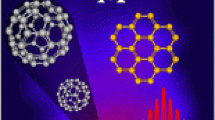Abstract.
The interaction of large ammonia clusters in the size range from n=20 to 2000 with photons and electrons are investigated in a reflectron time-of-flight mass spectrometer. The clusters are generated in adiabatic expansions through conical nozzles. The clusters are detected by (1+1) resonance-enhanced multiphoton ionization via the a state at 193 nm or electron impact ionization. By varying the power density of the laser between 20 and 1000 kW cm-2 and the electron energy between 50 and 1000 eV, the clusters were largely fragmented. The operating mechanisms were identified as those responsible for the electronic sputtering of solid matter. The yields, however, were orders of magnitude larger than those for the solid. This result is a consequence of the finite dimensions of the cluster which cannot accommodate the energy.
Similar content being viewed by others
Author information
Authors and Affiliations
Additional information
Received: 12 August 1999 / Accepted: 16 August 1999 / Published online: 28 December 1999
Rights and permissions
About this article
Cite this article
Schütte, S., Buck, U. Cluster sputtering: complete fragmentation of large ammonia clusters by photons and electrons . Appl Phys A 69 (Suppl 1), S209–S211 (1999). https://doi.org/10.1007/s003399900390
Issue Date:
DOI: https://doi.org/10.1007/s003399900390




